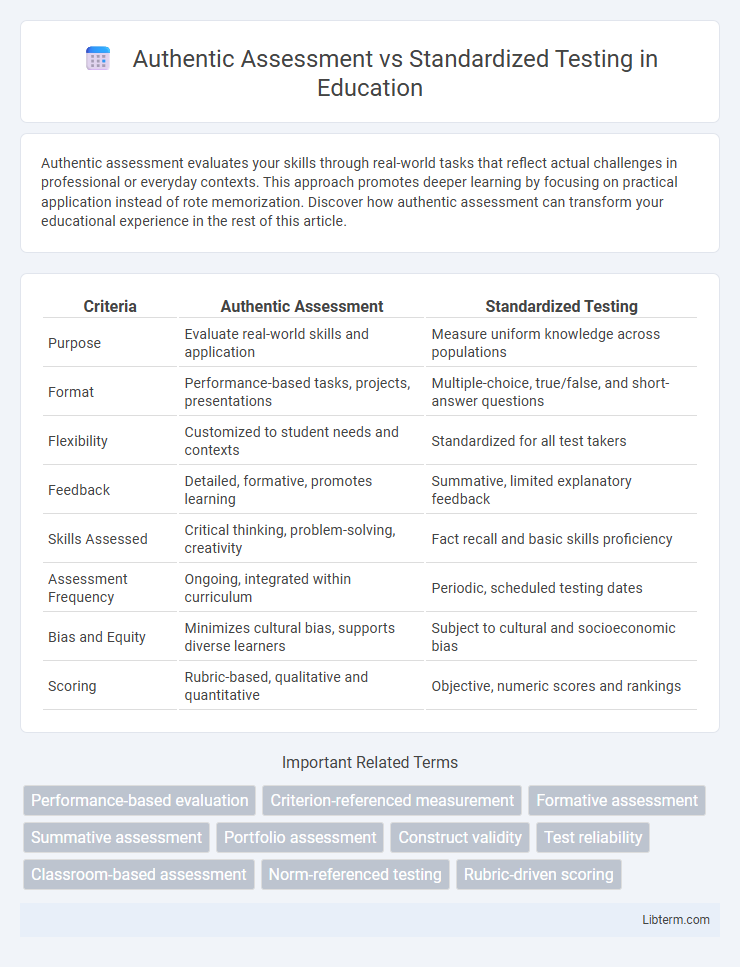Authentic assessment evaluates your skills through real-world tasks that reflect actual challenges in professional or everyday contexts. This approach promotes deeper learning by focusing on practical application instead of rote memorization. Discover how authentic assessment can transform your educational experience in the rest of this article.
Table of Comparison
| Criteria | Authentic Assessment | Standardized Testing |
|---|---|---|
| Purpose | Evaluate real-world skills and application | Measure uniform knowledge across populations |
| Format | Performance-based tasks, projects, presentations | Multiple-choice, true/false, and short-answer questions |
| Flexibility | Customized to student needs and contexts | Standardized for all test takers |
| Feedback | Detailed, formative, promotes learning | Summative, limited explanatory feedback |
| Skills Assessed | Critical thinking, problem-solving, creativity | Fact recall and basic skills proficiency |
| Assessment Frequency | Ongoing, integrated within curriculum | Periodic, scheduled testing dates |
| Bias and Equity | Minimizes cultural bias, supports diverse learners | Subject to cultural and socioeconomic bias |
| Scoring | Rubric-based, qualitative and quantitative | Objective, numeric scores and rankings |
Understanding Authentic Assessment
Authentic assessment emphasizes evaluating students' abilities through real-world tasks that demonstrate practical application of knowledge, fostering deeper learning and critical thinking skills. Unlike standardized testing, which measures performance through uniform questions and scoring, authentic assessments include portfolios, projects, and presentations tailored to individual learning contexts. This approach supports comprehensive understanding by capturing diverse skills and cognitive processes that standardized tests often overlook.
Defining Standardized Testing
Standardized testing refers to a uniform assessment method where all test takers answer the same questions under consistent conditions, allowing for objective comparison of performance across diverse populations. These tests are designed to measure specific skills or knowledge areas, often using multiple-choice or true/false formats, and are scored in a consistent, predetermined manner. Standardized testing aims to provide reliable, quantifiable data for evaluating educational outcomes and informing policy decisions.
Key Differences Between Authentic Assessment and Standardized Testing
Authentic assessment evaluates students' skills through real-world tasks and projects, emphasizing critical thinking and problem-solving, whereas standardized testing relies on multiple-choice or short-answer formats designed for large-scale comparison and statistical analysis. Authentic assessments provide detailed insights into individual learning processes and practical application, while standardized tests offer uniformity and reliability in measuring performance across diverse populations. The key difference lies in the purpose and format: authentic assessment fosters deeper understanding and personalized feedback, whereas standardized testing prioritizes consistency and broad evaluative benchmarks.
Benefits of Authentic Assessment
Authentic assessment offers a comprehensive evaluation of students' critical thinking, problem-solving abilities, and real-world application of knowledge, unlike standardized testing which often measures rote memorization. It enhances learner engagement by allowing students to demonstrate their understanding through projects, presentations, and practical tasks that mirror real-life situations. This method provides educators with detailed insights into individual student strengths and learning progress, fostering personalized instruction and skill development.
Limitations of Standardized Testing
Standardized testing often fails to capture students' critical thinking and creativity, limiting its effectiveness in measuring true understanding. It tends to emphasize rote memorization and narrow content areas, which can disadvantage diverse learners and stifle individualized learning approaches. Furthermore, standardized tests may produce biased results due to socioeconomic factors, leading to inequitable educational outcomes.
Impact on Student Learning
Authentic assessment enhances student learning by promoting critical thinking, problem-solving, and application of knowledge in real-world contexts, thereby improving retention and deeper understanding. Standardized testing primarily measures rote memorization and uniform knowledge, often limiting opportunities for creative and analytical skills development. Research indicates that students engaged in authentic assessment demonstrate higher motivation and better mastery of subject matter compared to those relying solely on standardized test performance.
Role of Teachers in Both Assessment Methods
Teachers play a crucial role in authentic assessment by designing and implementing tasks that reflect real-world challenges, allowing them to evaluate students' critical thinking, problem-solving skills, and creativity in context. In standardized testing, educators primarily administer and prepare students for uniform exams focused on measuring specific academic proficiency under controlled conditions, limiting their ability to tailor assessments to individual learning needs. The teacher's involvement in authentic assessment fosters personalized feedback and growth, whereas standardized testing emphasizes comparability and accountability across large populations.
Measuring Critical Thinking and Real-World Skills
Authentic assessment measures critical thinking and real-world skills by engaging students in complex, meaningful tasks that mirror real-life challenges, promoting deeper understanding and application of knowledge. Standardized testing typically emphasizes rote memorization and narrow skill sets, often failing to capture nuanced problem-solving abilities or practical competencies. By integrating performance-based evaluations, educators can better gauge students' analytical reasoning and adaptability crucial for success beyond the classroom.
Equity and Accessibility Considerations
Authentic assessment promotes equity and accessibility by allowing diverse learners to demonstrate knowledge through real-world tasks tailored to individual strengths, reducing cultural and linguistic biases common in standardized testing. Standardized testing often creates barriers for students with disabilities, language differences, and socioeconomic challenges due to uniform formats and time constraints that do not accommodate varied needs. Emphasizing flexible evaluation methods enhances inclusivity and provides a more accurate measure of student learning across diverse populations.
Choosing the Right Assessment Approach
Selecting the appropriate assessment approach hinges on the educational goals and learning outcomes targeted. Authentic assessment emphasizes real-world tasks and critical thinking, providing insights into students' practical skills and deeper understanding. Standardized testing offers quantifiable data for broad comparisons but may overlook individual creativity and context-specific knowledge, making it less suitable for evaluating complex competencies.
Authentic Assessment Infographic

 libterm.com
libterm.com